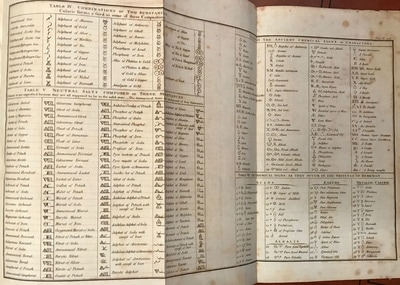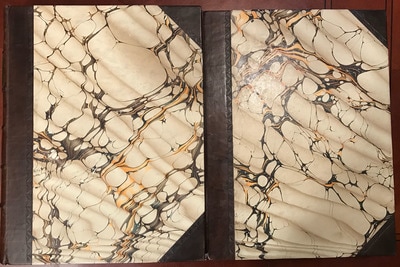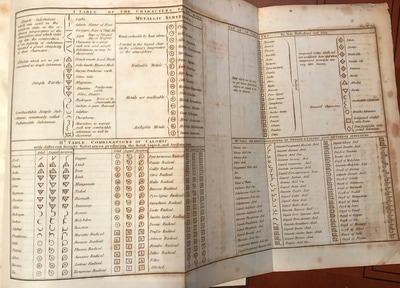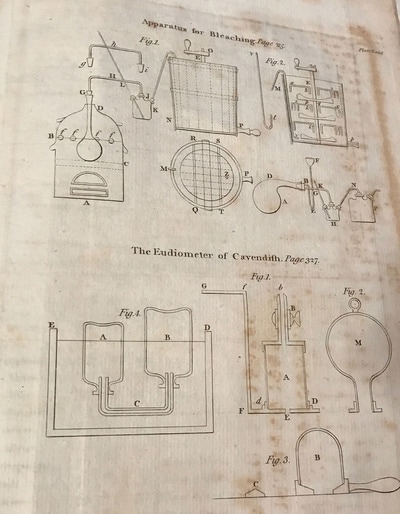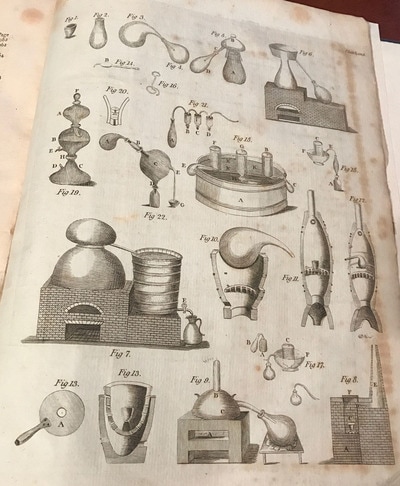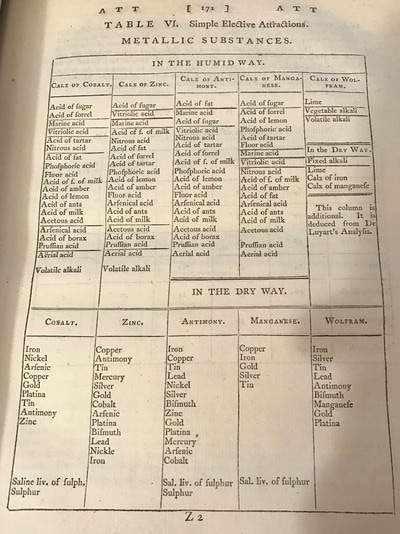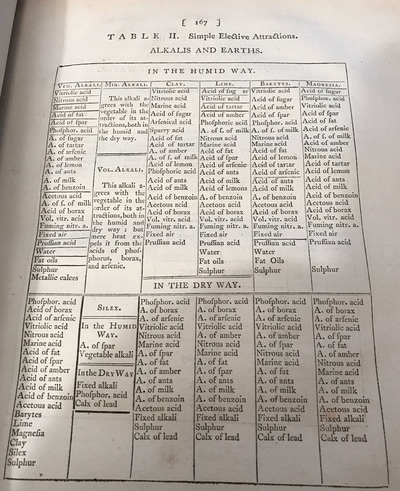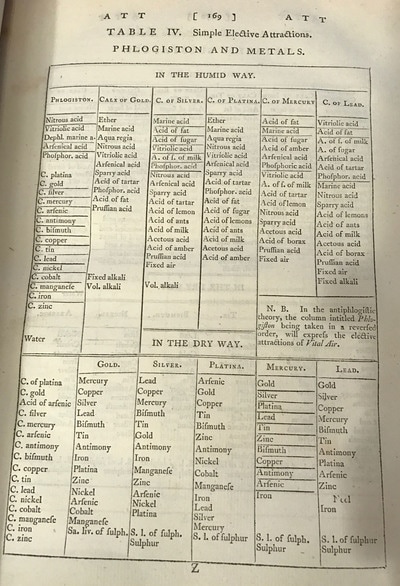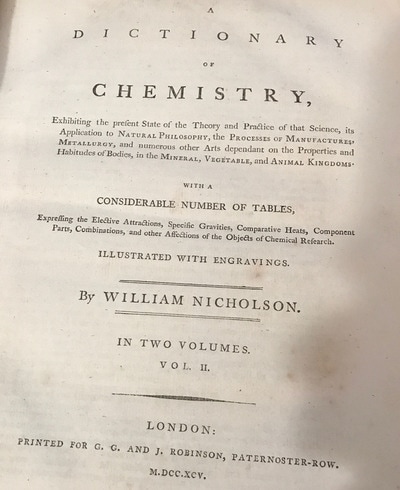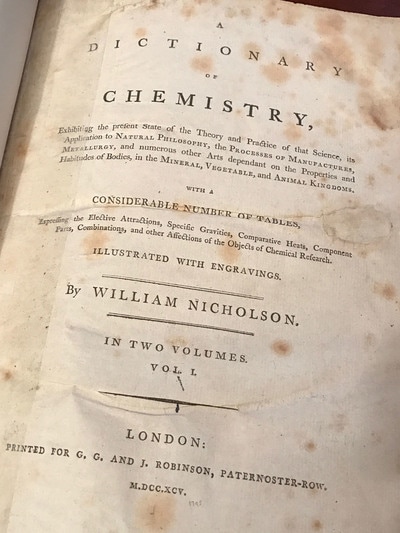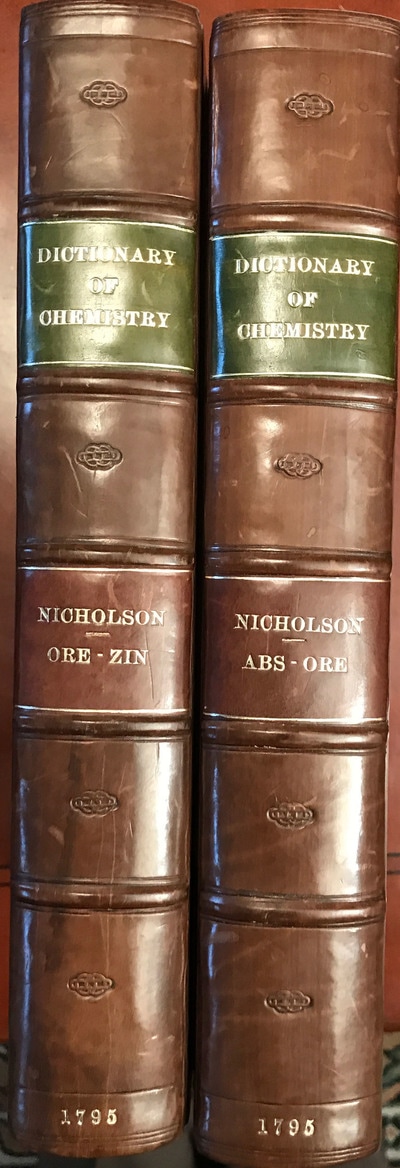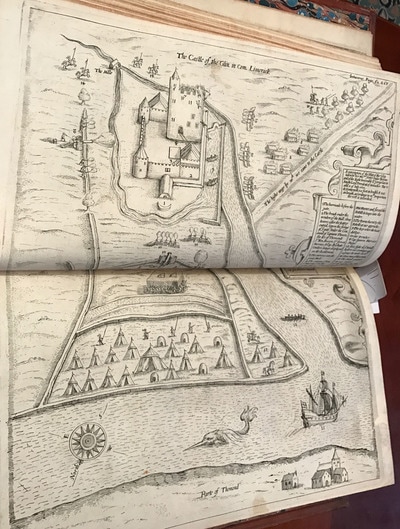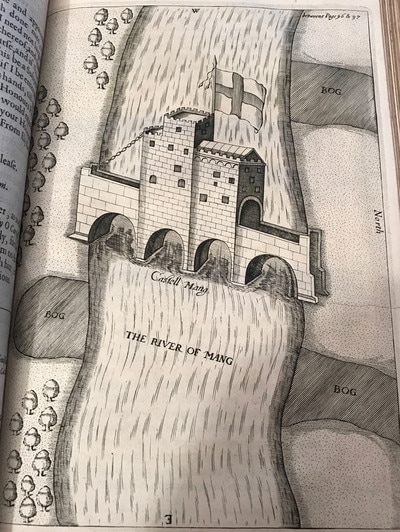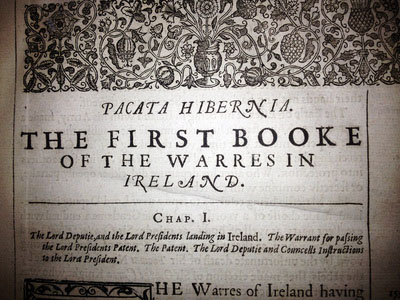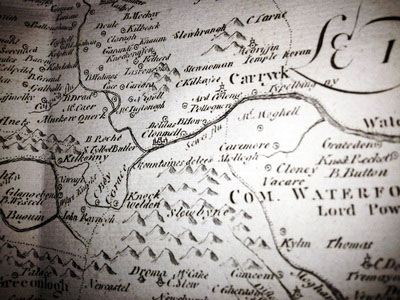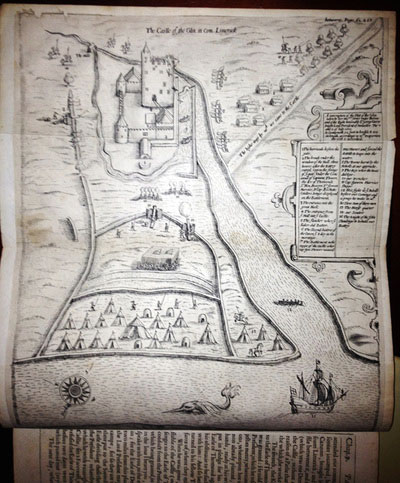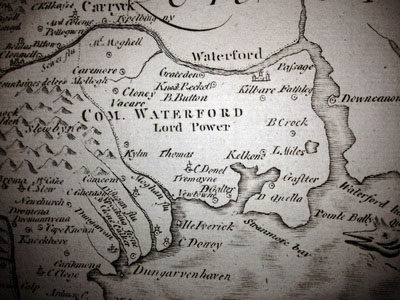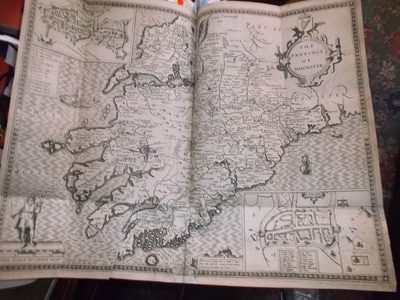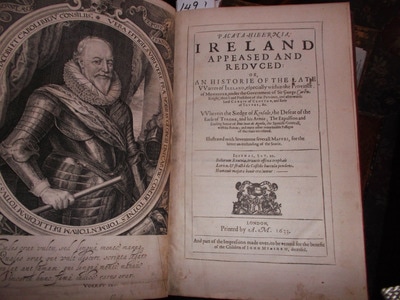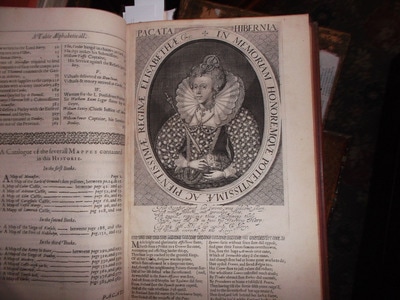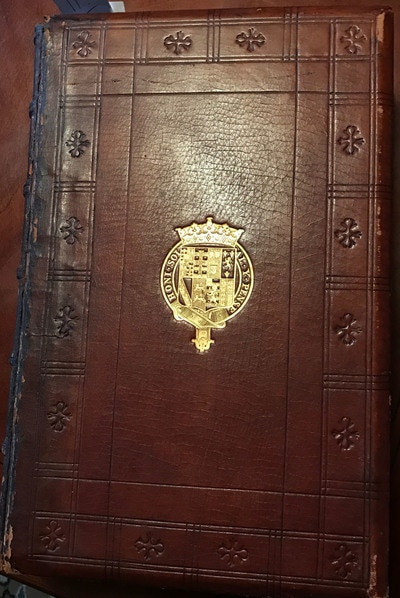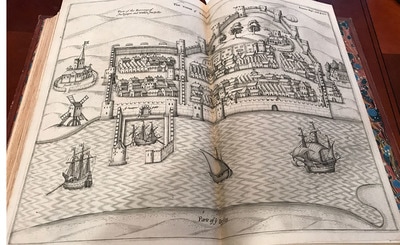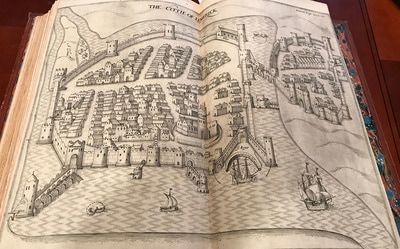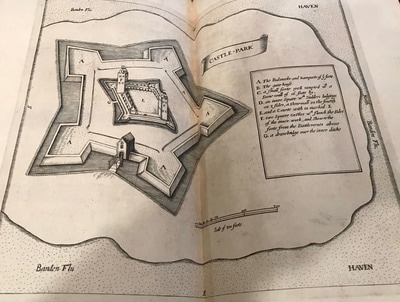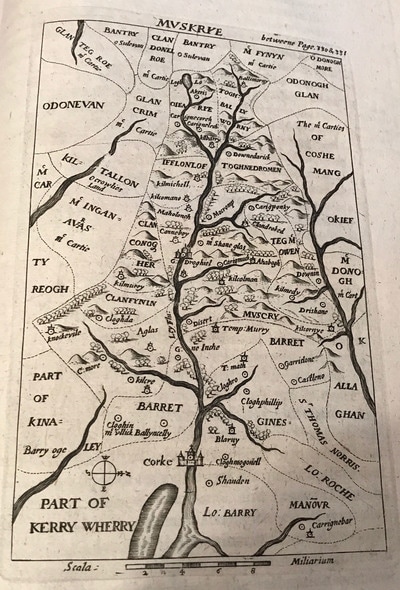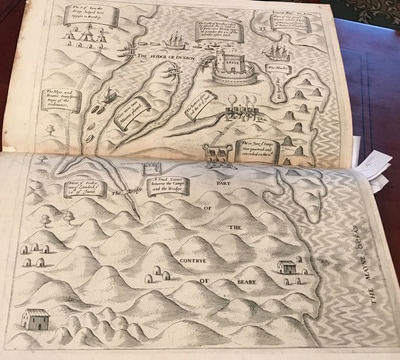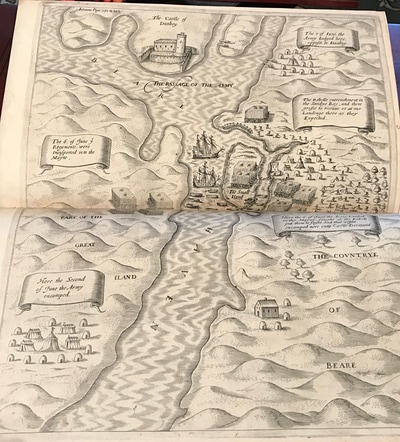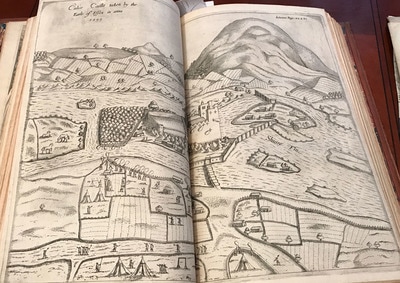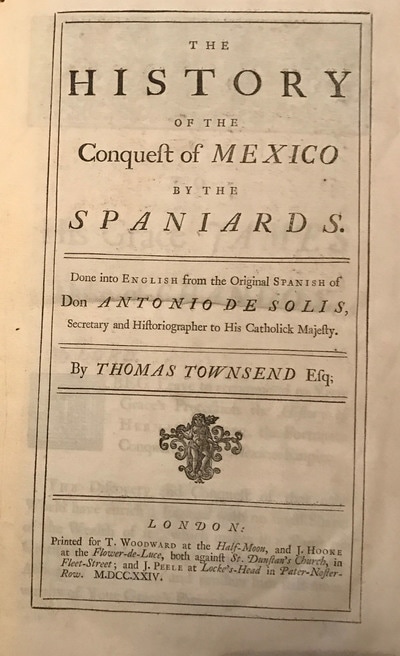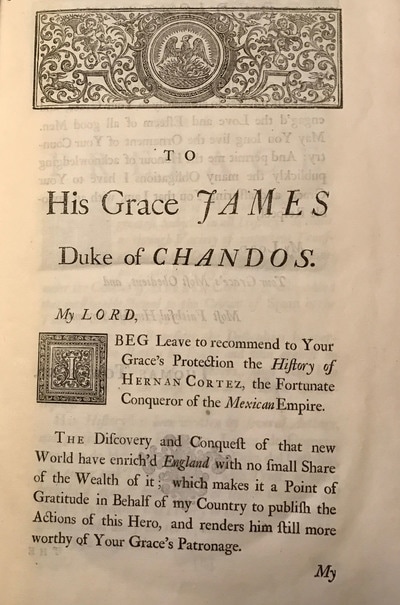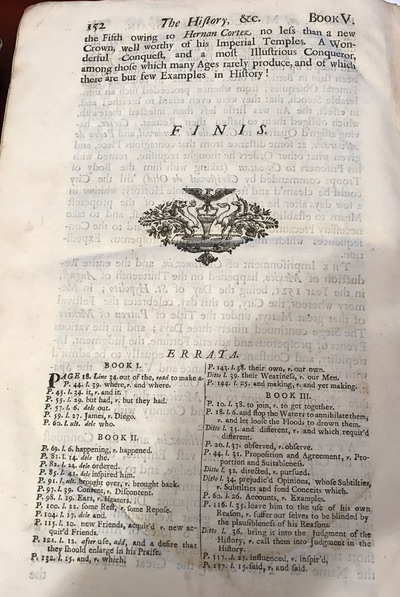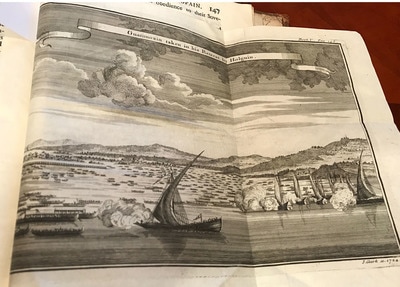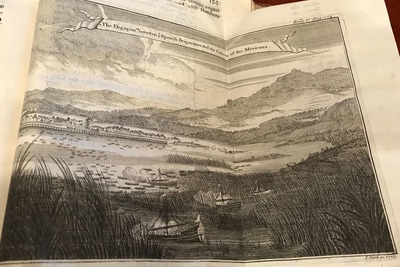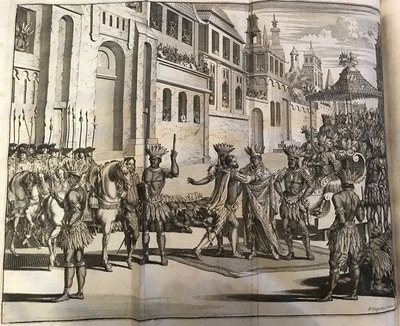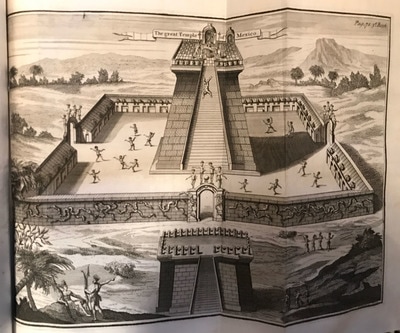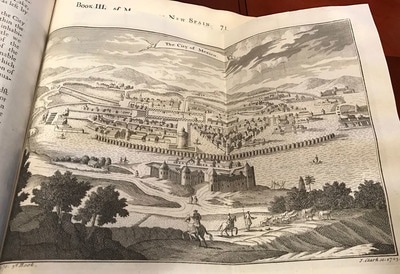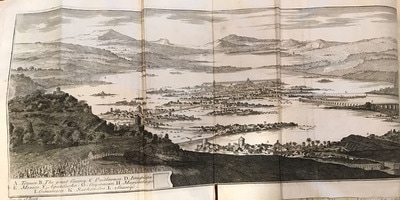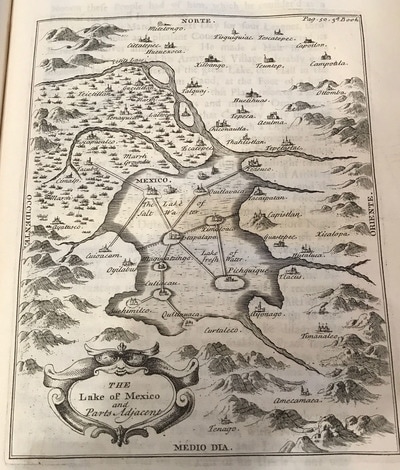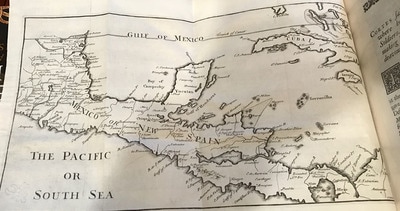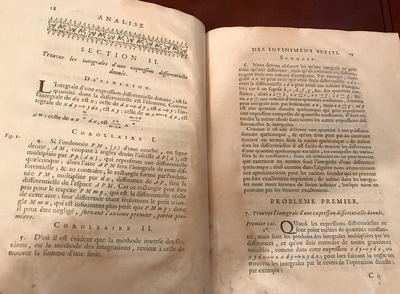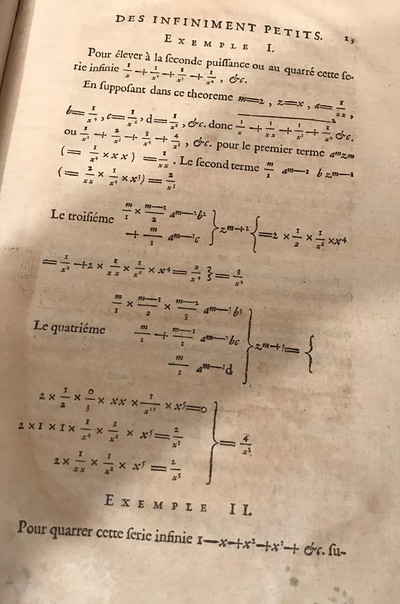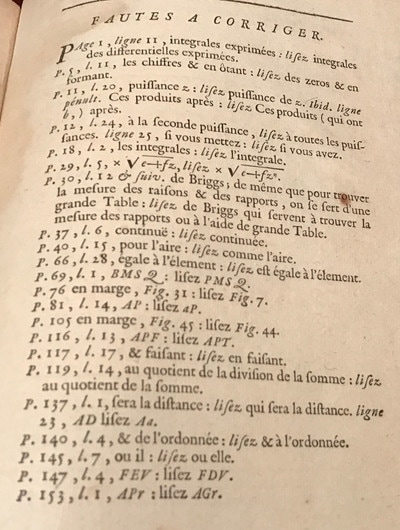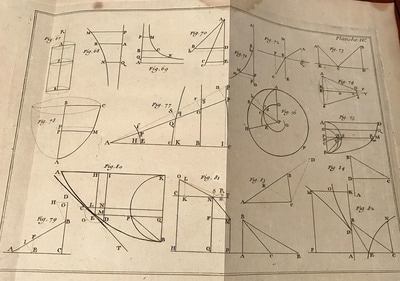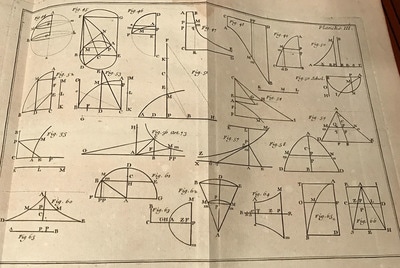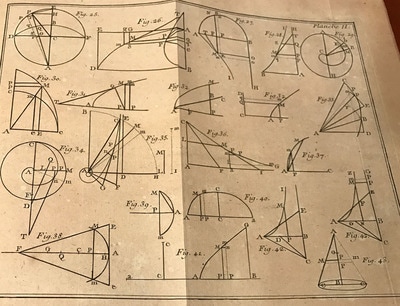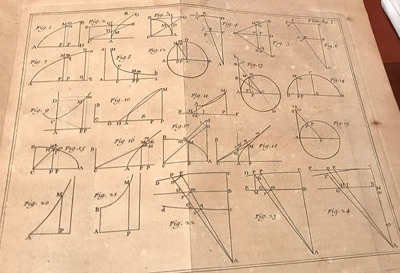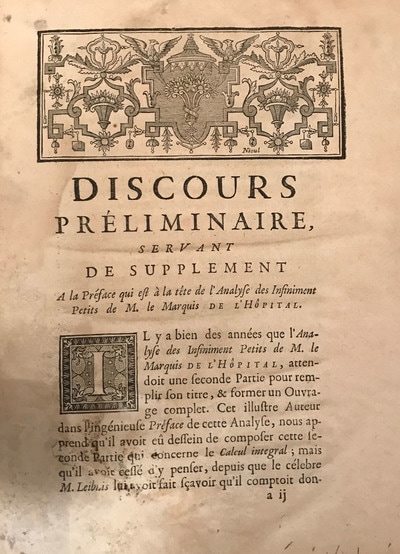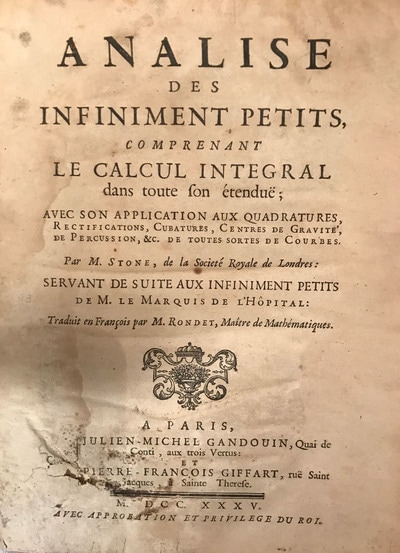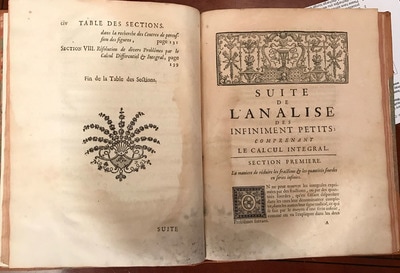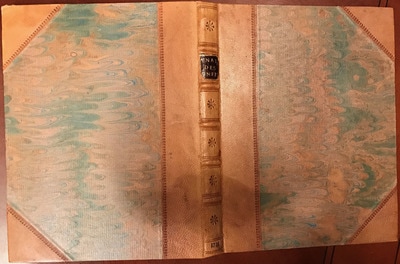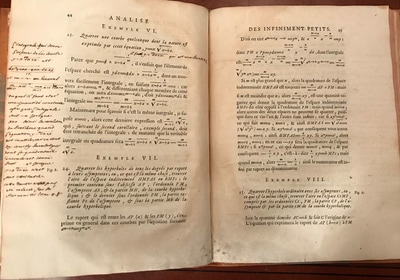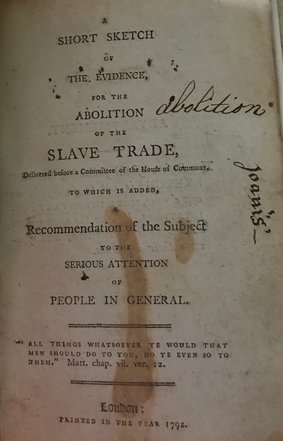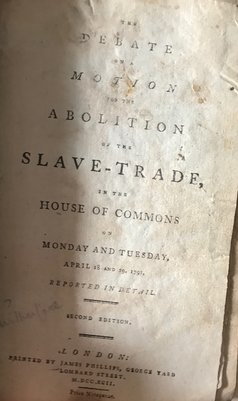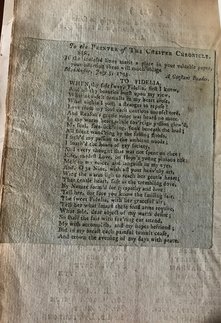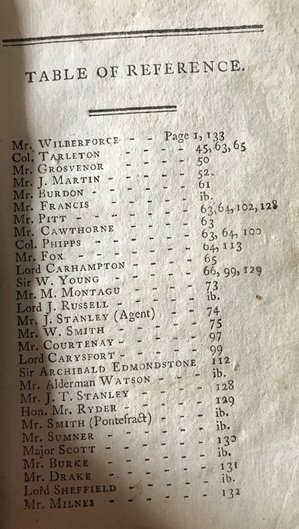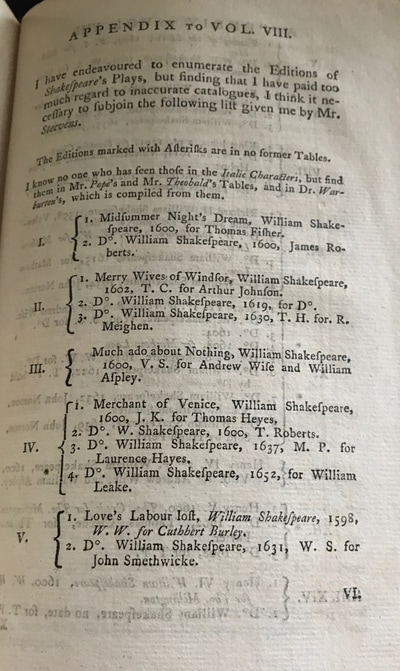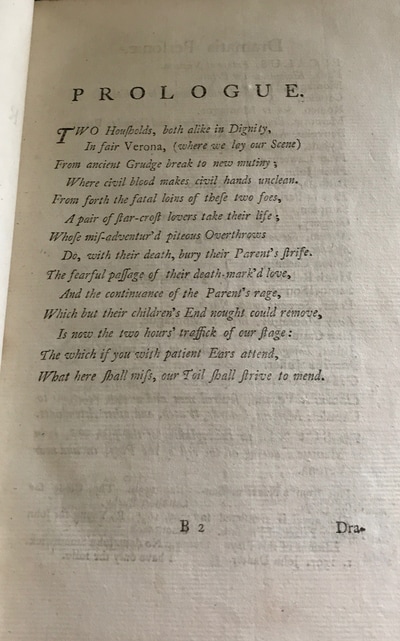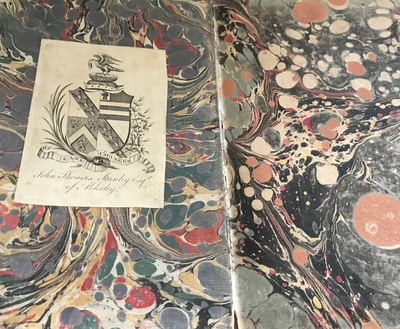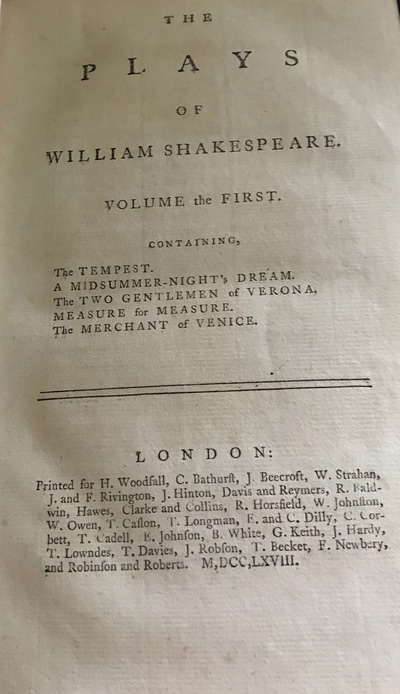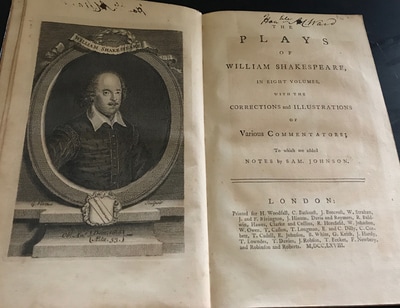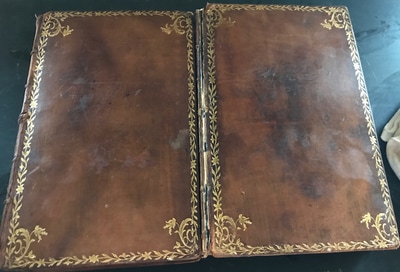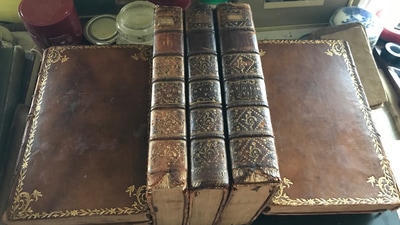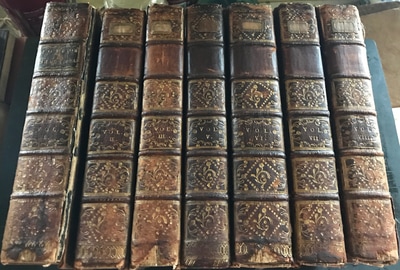RARE BOOKS JUST IN PAGE 5
Lexicon Technicum: 1708-1710
|
|
A Dictionary of Chemistry
|
|
Pacata Hibernia
|
|
The History of the Conquest of Mexico by the Spaniards;-
|
|
Analise des Infiniment Petits Comprenant le Calcul Integral;-
|
|
A short sketch of the evidence delivered before a committee of the House of Commons for the Abolition of the Slave -Trade. 1792A short sketch of the evidence delivered before a committee of the House of Commons for the Abolition of the Slave -Trade.
“ To which is added, a recommendation of the subject to the serious attention of People in General” By the writer W.B.C. (William Bell Crafton);- The writer and humanitarian William Bell Crafton;- This Pamphlet by William Bell Crafton, Favoured abolition on the grounds of morality and Justice. Published in London, 1792.. 1st. Edition with 24 pages stitched, as issued. A Pamphlet or Tract is a small booklet or leaflet containing information or arguments about a single subject. A Pamphlet or Tract is also an unbound sheet of paper without a hard-cover or binding It may consist of a single sheet of paper that is printed on both sides and folded in half, in thirds, or in fourths, called a leaflet, or it may consist of a few pages that are folded in half and saddled stabled (staples into the spine ) at the crease to make a simple booklet. The pamphlet form of literature has been used for centuries as an economical vehicle for the broad distribution of information. Also due to their low cost and ease of production, Pamphlets have often been used to popularise political or religious ideas. Ephemeral (Pamphlets or Tracts) and to wide array of political or religious perspectives given voice by the format's ease of production, Pamphlets are prized by many Book Collectors, Research Libraries, Private Institutions such as Universities. Substantial accumulations have been amassed and transferred to ownership of academic Research Libraries around the world. Also Pamphlets or Tracts were printed on scarce paper at the time, so when finished were more often then not used as toilet paper, (toilet paper at the time was non existent,) or also used to start a home fire, so paper Pamphlets or Tracts rarely survived, hence there greater value. This 24 page Pamphlet is a very good topic on the Slave-Trade in the 18th. century. The Pamphlet is in its original state, untrimmed, wrapped in marbled paper wraps. 1st. Edition thus. “All things whatsoever ye would that men should do to you, do ye ever so to them” Matt. chap. vii. ver. 12 …Original 1st. Edition Pamphlet of 1792, with a few antiquarian notes to flypapers covers, a brown stain to the title page, otherwise in fine collectible condition of an exceptionally collectible Pamphlet in its unbound state as originally issued. Rare and scarce as is always the case with any early Pamphlets. No other 1st. Edition of this Pamphlet on the Slave-Trade to be found anywhere on the internet nor auction house records, a very unique copy of an early anti-slavery Tract, $2,750. Little is recorded about William Bell Crafton, we know he was a prolific writer on abolitionist Pamphlets about the Slave-Trade, we have many of his Pamphlets and Tracts that survived to this day. William Bell Crafton was it would appear that is called a Pamphleteer, a writer of Pamphlets, especially ones of a political and controversial nature. He was friends with wide range of fellow travellers in and around London, like, the printer and Published Martha Gurney of Holborn, William Fox, William Pitt, and William Wilberforce, leading light of the anti-slavery movement. Martha Gurney, unusual for a woman at the time, a female printer and Publisher, Martha Gurney, her name appeared as printer and seller on more than 130 titles, including twenty-five editions of state trials and other court proceedings transcribed by her brother between 1781 and 1813. Besides printing and selling sermons, court trials, and abolitionist Pamphlets. This “A short sketch of the evidence delivered before a committee of the House of Commons for the Abolition of the Slave -Trade Pamphlet, was probably Printed and Published by Martha Gurney together with William Fox, William Bell Crafton, and William Wilberforce all were against the Slave Trade. William Fox was among the most prolific radical Pamphleteers of the 1790s. Between 1791 and 1794, he collaborated with the Baptist bookseller Martha Gurney in publishing sixteen political Pamphlets on topics ranging from the abolition of the slave trade to the perversion of national fast days, from England’s war with France to the government’s selective redefining of the word ‘Jacobin.’ His most famous work, An Address to the People of Great Britain, on the Propriety of Refraining from the Use of West India Sugar and Rum (1791), solidified the abolitionist forces in Great Britain and America by focusing their energies on a boycott of West Indian produce, a boycott that served not only as a viable economic solution to ending the slave trade but also, as Charlotte Sussman argues, provided through the power of ‘consumerism’ a kind of universal suffrage for its advocates, resulting in a political campaign that bypassed Parliament and granted power directly to the people, many of whom were of the lower and middle classes. William Fox operated a bookshop at 128 Holborn Hill, appearing as a bookseller on at least fifty-six titles, although usually as a member of a consortium of sellers. In 1782 he entered into a business arrangement with Martha Gurney (1733-1816), who that year moved her bookshop from 34 Bell-yard into his quarters in Holborn Hill, where she would remain until her death in 1816. She was the only daughter of Thomas Gurney (1705-70), a High Calvinist Baptist who served for many years as a shorthand writer at the Old Bailey. Her brother, Joseph Gurney (1744-1815), was also a bookseller before succeeding his father as shorthand writer for the Old Bailey and later for Parliament. Joseph Gurney may have introduced his sister to William Fox, for the two men, besides being printer/booksellers only a short distance from each other in Holborn, were also subscribing members to the Humane Society, founded in 1774 by Dr. William Hawes, a close friend of Joseph Gurney. |
The Debate on a Motion for the Abolition of the Slave-Trade, In the House of Commons on Monday and Tuesday April 18th. and 19th. 1791The Debate on a Motion for the Abolition of the Slave-Trade, In the House of Commons on Monday and Tuesday April 18th. and 19th. 1791;-
Published in London, by James Phillips 1792, 2nd Edition. Pamphlet form 134 pages, dark red marbled paper wraps as covers. Untrimmed papers which is normal for any Pamphlet or Tract published at the time. One or two contemporary hand written names in the margins with the Pamphlet, a few light brown stains also within, does not effects text, otherwise fairly clean throughout. Title page a little grubby, second page with a “Table of Reference” list of 29 people starting with William Wilberforce, other names Pitt, Fox Burke, etc…Page 133 the Vote numbers, plus again list of 29 people starting with William Wilberforce, other names Pitt, Fox, Burke, etc…who voted. This even as a 2nd Edition Pamphlet is very rare and scarce in this fine collectable condition, with 134 pages stitched, as issued. The 1st. Edition was the debate which took place on the Monday the 2nd. of April 1792. My Pamphlet was the debate the year before in 1791, Monday and Tuesday April 18th. and 19th. So really a 1st. Edition of 1791, but printed in 1792. Title page in situ, with a newspaper cutting of 1792, “a Poem” on the subject of “Sugar”, pasted to the back blank page after the main title, also the last blank page another newspaper article, “a Poem”, printed in 1793, also pasted on the last blank page of the booklet. A Rare and very Scarce Pamphlet with the debate by William Wilberforce, a historical document in its original form…$3,875 as is. A Pamphlet or Tract is a small booklet or leaflet containing information or arguments about a single subject. A Pamphlet or Tract is also an unbound sheet of paper without a hard-cover or binding It may consist of a single sheet of paper that is printed on both sides and folded in half, in thirds, or in fourths, called a leaflet, or it may consist of a few pages that are folded in half and saddled stabled (staples into the spine ) at the crease to make a simple booklet. The pamphlet form of literature has been used for centuries as an economical vehicle for the broad distribution of information. Also due to their low cost and ease of production, Pamphlets have often been used to popularise political or religious ideas. Ephemeral (Pamphlets or Tracts) and to wide array of political or religious perspectives given voice by the format's ease of production, Pamphlets are prized by many Book Collectors, Research Libraries, Private Institutions such as Universities. Substantial accumulations have been amassed and transferred to ownership of academic Research Libraries around the world. Also Pamphlets or Tracts were printed on scarce paper at the time, so when finished were more often then not used as toilet paper, (toilet paper at the time was non existent,) or also used to start a home fire, so paper Pamphlets or Tracts rarely survived, hence there greater value. William Wilberforce supported the campaign for the complete abolition of slavery, and continued his involvement after 1826, when he resigned from Parliament because of his failing health. That campaign led to the Slavery Abolition Act 1833, which abolished slavery in most of the British Empire. Wilberforce died just three days after hearing that the passage of the Act through Parliament was assured. He was buried in Westminster Abbey, he was a close to his friend Prime Minister William Pitt. On 12 May 1789, William Wilberforce made his first major speech on the subject of abolition of Slavery in the House of Commons, in which he reasoned that the trade was morally reprehensible and an issue of natural justice. Drawing on Thomas Clarkson's mass of evidence, he described in detail the appalling conditions in which Slaves travelled from Africa in the middle passage, and argued that abolishing the trade would also bring an improvement to the conditions of existing slaves in the West Indies. Wilberforce moved 12 resolutions in the House of Commons condemning the slave trade, but made no reference to the abolition of slavery itself, instead dwelling on the potential for reproduction in the existing slave population should the trade be abolished. With the tide running against them, the opponents of abolition delayed the vote by proposing that the House of Commons hear its own evidence, and Wilberforce, in a move that has subsequently been criticised for prolonging the slave trade, reluctantly agreed. On 2 April 1792, Wilberforce again brought a bill calling for abolition. The memorable debate that followed drew contributions from the greatest orators in the house, William Pitt, Charles James Fox, as well as from Wilberforce himself. |
An Essay on Man in Four Epistles by Alexander Pope;- 1771
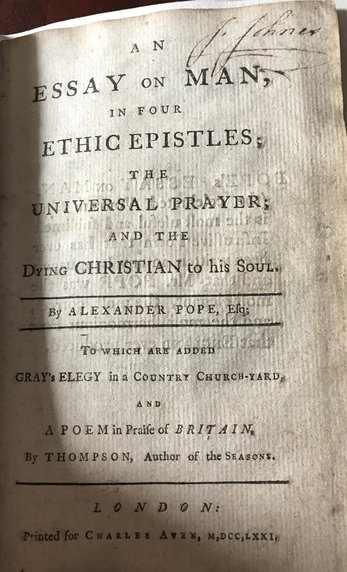
An Essay on Man in Four Epistles by Alexander Pope;-
To which are added Grey’s Elegy in a Country Church - Yard and
A Poem in Praise of Britain by Thompson, author of the Seasons.
Published in London by Charles Aven in 1771. An early edition of 1771 of the three great English Poets;- Pope, Grey, and Thompson. A Published Pamphlet with 60 pages, in red and blue marbled paper wraps. Antiquarian Signature of J. Jones to the right top side of the title page, untrimmed brownish paper, in fine collectable condition, rare and scarce in Pamphlet form. $350
An Essay on Man is a poem published by Alexander Pope in 1733- 1734 Pope's Essay on Man and Moral Epistles were designed to be the parts of a system of ethics which he wanted to express in poetry. The essay, written in heroic couplets, comprises four epistles. Pope began work on it in 1729, and had finished the first three by 1731. They appeared in early 1733, with the fourth epistle published the following year. The poem was originally published anonymously; Pope did not admit authorship until 1735. On its publication, An Essay on Man received great admiration throughout Europe. Voltaire called it "the most beautiful, the most useful, the most sublime didactic poem ever written in any language". In 1756 Rousseau wrote to Voltaire admiring the poem and saying that it "softens my ills and brings me patience". Kant was fond of the poem and would recite long passages from it to his students. Later however, Voltaire renounced his admiration for Pope's and Leibniz’s optimism and even wrote a novel, Candide, as a satire on their philosophy of ethics. Rousseau also critiqued the work, questioning "Pope's uncritical assumption that there must be an unbroken chain of being all.
Grey’s Elegy in a Country Church - Yard was completed in 1750 and first published in 1751.
The Poem in Praise of Britain by James Thompson, author of the Seasons. James Thompson also wrote "Rule, Britannia!" and it was set to music by Thomas Arne in 1740
To which are added Grey’s Elegy in a Country Church - Yard and
A Poem in Praise of Britain by Thompson, author of the Seasons.
Published in London by Charles Aven in 1771. An early edition of 1771 of the three great English Poets;- Pope, Grey, and Thompson. A Published Pamphlet with 60 pages, in red and blue marbled paper wraps. Antiquarian Signature of J. Jones to the right top side of the title page, untrimmed brownish paper, in fine collectable condition, rare and scarce in Pamphlet form. $350
An Essay on Man is a poem published by Alexander Pope in 1733- 1734 Pope's Essay on Man and Moral Epistles were designed to be the parts of a system of ethics which he wanted to express in poetry. The essay, written in heroic couplets, comprises four epistles. Pope began work on it in 1729, and had finished the first three by 1731. They appeared in early 1733, with the fourth epistle published the following year. The poem was originally published anonymously; Pope did not admit authorship until 1735. On its publication, An Essay on Man received great admiration throughout Europe. Voltaire called it "the most beautiful, the most useful, the most sublime didactic poem ever written in any language". In 1756 Rousseau wrote to Voltaire admiring the poem and saying that it "softens my ills and brings me patience". Kant was fond of the poem and would recite long passages from it to his students. Later however, Voltaire renounced his admiration for Pope's and Leibniz’s optimism and even wrote a novel, Candide, as a satire on their philosophy of ethics. Rousseau also critiqued the work, questioning "Pope's uncritical assumption that there must be an unbroken chain of being all.
Grey’s Elegy in a Country Church - Yard was completed in 1750 and first published in 1751.
The Poem in Praise of Britain by James Thompson, author of the Seasons. James Thompson also wrote "Rule, Britannia!" and it was set to music by Thomas Arne in 1740
The Oeconomy of Love by Dr. Armstrong;- 1771
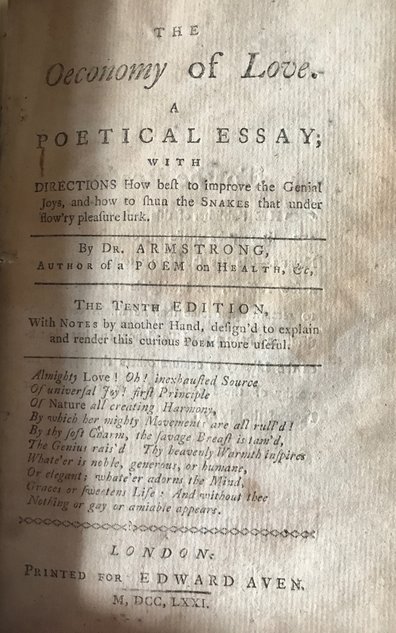
The Oeconomy of Love by Dr. Armstrong;- 1771
This 26 page Pamphlet was Published in London by Edward Even 1771- Dr. John Armstrong was a Doctor, Poet, and Satirist . The Oeconomy of Love, a poetical essay; with directions how best to improve the genial joys, and how to shun the Snakes that under flow'ry pleasure lurk. Dr. Armstrong greatest poem was "The Oeconomy of Love"The "Oeconomy Of Love" has been described as an eighteenth-century guide to sex and is particularly interesting in that the lines:
"To shed thy blossoms thro' the desert air, And sow thy perish'd offspring in the winds" are thought to be a possible inspiration for the more famous lines by Thomas Gray contained in his "Elegy Written in a Country Church-Yard" as follows:
"Full many a flower is born to blush unseen, And waste its sweetness on the desert air.”
However John Armstrong's use of floral metaphor in the "Oeconomy of Love" refers to the unnecessary shedding of semen whilst the author cautions young men against sexual practices that he condemns in his role as poet and physician.
1st. Edition Pamphlet edition, is scarce. Dr. Armstrong was a doctor by profession, and published serious medical works “The Art of Preserving Health”. But he was also a poet, best known for the explicit verse sex manual The Oeconomy of Love first published in 1736, and the rather more respectable The Art of preserving Health 1744. He was a friend of fellow literary Scots Tobias Smollett and James Thomson, and also of the young rake and rising politician John Wilkes. 'On 18 April 1760 Armstrong sailed from Harwich as physician to the English Army in Germany, a post he perhaps owed to Wilkes's patronage. Armstrong return to London early in 1763. He died in 1779
This 26 page Pamphlet was Published in London by Edward Even 1771- Dr. John Armstrong was a Doctor, Poet, and Satirist . The Oeconomy of Love, a poetical essay; with directions how best to improve the genial joys, and how to shun the Snakes that under flow'ry pleasure lurk. Dr. Armstrong greatest poem was "The Oeconomy of Love"The "Oeconomy Of Love" has been described as an eighteenth-century guide to sex and is particularly interesting in that the lines:
"To shed thy blossoms thro' the desert air, And sow thy perish'd offspring in the winds" are thought to be a possible inspiration for the more famous lines by Thomas Gray contained in his "Elegy Written in a Country Church-Yard" as follows:
"Full many a flower is born to blush unseen, And waste its sweetness on the desert air.”
However John Armstrong's use of floral metaphor in the "Oeconomy of Love" refers to the unnecessary shedding of semen whilst the author cautions young men against sexual practices that he condemns in his role as poet and physician.
1st. Edition Pamphlet edition, is scarce. Dr. Armstrong was a doctor by profession, and published serious medical works “The Art of Preserving Health”. But he was also a poet, best known for the explicit verse sex manual The Oeconomy of Love first published in 1736, and the rather more respectable The Art of preserving Health 1744. He was a friend of fellow literary Scots Tobias Smollett and James Thomson, and also of the young rake and rising politician John Wilkes. 'On 18 April 1760 Armstrong sailed from Harwich as physician to the English Army in Germany, a post he perhaps owed to Wilkes's patronage. Armstrong return to London early in 1763. He died in 1779
The New Handmaid to Arts, Sciences, Agriculture, 1790
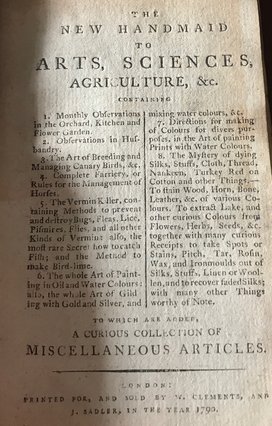
The New Handmaid to Arts, Sciences, Agriculture, 1790
The New Handmaid to Arts, Sciences, Agriculture, &c. Containing 1. Prognostications for the weather 6. The most rare secret how to catch fish; also the method to make bird-lime. Together with the whole art of limning and painting, in oil and water colours. Also the art of gilding ... The method of colouring maps ... The curious art and mystery of japaning [!] ... with many other things worthy of note
Published in London, by W. Clements, and J. Sadler, 1790. This 118 pages 1st. Edition Pamphlet by Multiple Contributors. The new handmaid to arts, sciences, agriculture, &c. in nine booklets, to which is added the complete farriery or rules for the management of horses and various articles on the Arts, Sciences, and Agriculture subjects. The other subjects are “Observations in the Orchard”, the Mystery of Dying Silks. Original 1st. Edition Pamphlet with green and gold marbled paper covers. Title-Page present with an old contemporary hand-written signature to the very end of the Title-Page. Some slight wear and creases on the pages otherwise in fine collectable condition, rare and scarce in Pamphlet form. $350
A Pamphlet or Tract is a small booklet or leaflet containing information or arguments about a single subject. A Pamphlet or Tract is also an unbound sheet of paper without a hard-cover or binding It may consist of a single sheet of paper that is printed on both sides and folded in half, in thirds, or in fourths, called a leaflet, or it may consist of a few pages that are folded in half and saddled stabled (staples into the spine ) at the crease to make a simple booklet. The pamphlet form of literature has been used for centuries as an economical vehicle for the broad distribution of information. Also due to their low cost and ease of production, Pamphlets have often been used to popularise political or religious ideas. Ephemeral (Pamphlets or Tracts) and to wide array of political or religious perspectives given voice by the format's ease of production, Pamphlets are prized by many Book Collectors, Research Libraries, Private Institutions such as Universities. Substantial accumulations have been amassed and transferred to ownership of academic Research Libraries around the world. Also Pamphlets or Tracts were printed on scarce paper at the time, so when finished were more often then not used as toilet paper, (toilet paper at the time was non existent,) or also used to start a home fire, so paper Pamphlets or Tracts rarely survived, hence there greater value.
The New Handmaid to Arts, Sciences, Agriculture, &c. Containing 1. Prognostications for the weather 6. The most rare secret how to catch fish; also the method to make bird-lime. Together with the whole art of limning and painting, in oil and water colours. Also the art of gilding ... The method of colouring maps ... The curious art and mystery of japaning [!] ... with many other things worthy of note
Published in London, by W. Clements, and J. Sadler, 1790. This 118 pages 1st. Edition Pamphlet by Multiple Contributors. The new handmaid to arts, sciences, agriculture, &c. in nine booklets, to which is added the complete farriery or rules for the management of horses and various articles on the Arts, Sciences, and Agriculture subjects. The other subjects are “Observations in the Orchard”, the Mystery of Dying Silks. Original 1st. Edition Pamphlet with green and gold marbled paper covers. Title-Page present with an old contemporary hand-written signature to the very end of the Title-Page. Some slight wear and creases on the pages otherwise in fine collectable condition, rare and scarce in Pamphlet form. $350
A Pamphlet or Tract is a small booklet or leaflet containing information or arguments about a single subject. A Pamphlet or Tract is also an unbound sheet of paper without a hard-cover or binding It may consist of a single sheet of paper that is printed on both sides and folded in half, in thirds, or in fourths, called a leaflet, or it may consist of a few pages that are folded in half and saddled stabled (staples into the spine ) at the crease to make a simple booklet. The pamphlet form of literature has been used for centuries as an economical vehicle for the broad distribution of information. Also due to their low cost and ease of production, Pamphlets have often been used to popularise political or religious ideas. Ephemeral (Pamphlets or Tracts) and to wide array of political or religious perspectives given voice by the format's ease of production, Pamphlets are prized by many Book Collectors, Research Libraries, Private Institutions such as Universities. Substantial accumulations have been amassed and transferred to ownership of academic Research Libraries around the world. Also Pamphlets or Tracts were printed on scarce paper at the time, so when finished were more often then not used as toilet paper, (toilet paper at the time was non existent,) or also used to start a home fire, so paper Pamphlets or Tracts rarely survived, hence there greater value.
The Laws of Parliament in the present situation of Great Britain, considered. 1788
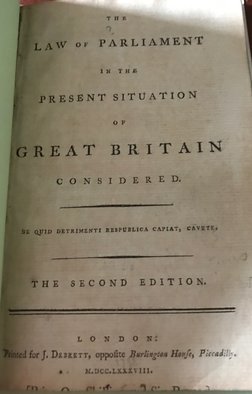
The Laws of Parliament in the present situation of Great Britain, considered. 1788
"Ne quid detrimenti respublica capiat, cavete.”
Original 58 pages, 2nd. Edition Pamphlet, Published by J. Debrett , opposite Burlington House, Piccadilly, London 1788;- On the question of a regency, occasioned by the insanity of George III; prefers making the Prince of Wales Regent to having a council of Regency. Two pages of Ads to the last two pages of the Pamphlet by the Publisher by J. Debrett. Red and Blue marbled paper wrappers, very clean throughout, last page brown stained with age. There are a very few surviving copies of the Pamphlet of 1788, in Universities, National Libraries in Great Britain, in their Pamphlet, the last two pages of Ads are missing, in this Pamphlet the last two pages of Ads are present. Highly collectable, rare and scarce in Pamphlet form, no other complete copies to be found.
A Pamphlet or Tract is a small booklet or leaflet containing information or arguments about a single subject. A Pamphlet or Tract is also an unbound sheet of paper without a hard-cover or binding It may consist of a single sheet of paper that is printed on both sides and folded in half, in thirds, or in fourths, called a leaflet, or it may consist of a few pages that are folded in half and saddled stabled (staples into the spine ) at the crease to make a simple booklet. The pamphlet form of literature has been used for centuries as an economical vehicle for the broad distribution of information. Also due to their low cost and ease of production, Pamphlets have often been used to popularise political or religious ideas. Ephemeral (Pamphlets or Tracts) and to wide array of political or religious perspectives given voice by the format's ease of production, Pamphlets are prized by many Book Collectors, Research Libraries, Private Institutions such as Universities. Substantial accumulations have been amassed and transferred to ownership of academic Research Libraries around the world. Also Pamphlets or Tracts were printed on scarce paper at the time, so when finished were more often then not used as toilet paper, (toilet paper at the time was non existent,) or also used to start a home fire, so paper Pamphlets or Tracts rarely survived, hence there greater value.
"Ne quid detrimenti respublica capiat, cavete.”
Original 58 pages, 2nd. Edition Pamphlet, Published by J. Debrett , opposite Burlington House, Piccadilly, London 1788;- On the question of a regency, occasioned by the insanity of George III; prefers making the Prince of Wales Regent to having a council of Regency. Two pages of Ads to the last two pages of the Pamphlet by the Publisher by J. Debrett. Red and Blue marbled paper wrappers, very clean throughout, last page brown stained with age. There are a very few surviving copies of the Pamphlet of 1788, in Universities, National Libraries in Great Britain, in their Pamphlet, the last two pages of Ads are missing, in this Pamphlet the last two pages of Ads are present. Highly collectable, rare and scarce in Pamphlet form, no other complete copies to be found.
A Pamphlet or Tract is a small booklet or leaflet containing information or arguments about a single subject. A Pamphlet or Tract is also an unbound sheet of paper without a hard-cover or binding It may consist of a single sheet of paper that is printed on both sides and folded in half, in thirds, or in fourths, called a leaflet, or it may consist of a few pages that are folded in half and saddled stabled (staples into the spine ) at the crease to make a simple booklet. The pamphlet form of literature has been used for centuries as an economical vehicle for the broad distribution of information. Also due to their low cost and ease of production, Pamphlets have often been used to popularise political or religious ideas. Ephemeral (Pamphlets or Tracts) and to wide array of political or religious perspectives given voice by the format's ease of production, Pamphlets are prized by many Book Collectors, Research Libraries, Private Institutions such as Universities. Substantial accumulations have been amassed and transferred to ownership of academic Research Libraries around the world. Also Pamphlets or Tracts were printed on scarce paper at the time, so when finished were more often then not used as toilet paper, (toilet paper at the time was non existent,) or also used to start a home fire, so paper Pamphlets or Tracts rarely survived, hence there greater value.
The Blessedness of those who are Persecuted for Righteous Sake, A Discourse 1792 ;- by Rev. J. Edwards
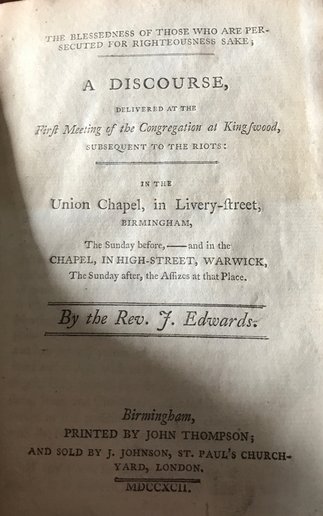
The Blessedness of those who are Persecuted for Righteous Sake, A Discourse 1792 ;- by Rev. J. Edwards
The blessedness of those who are persecuted for righteousness sake; a discourse, delivered at the first meeting of the congregation at Kingswood, subsequent to the riots: ... In the Union Chapel, in Livery-Street, Birmingham; The Sunday before——and in the Chapel, in High -Street, Warwick, The Sunday after, the Assizes at that Place. By the Rev. J. Edwards. (Rev. John Edwards)
With 48 pages, the final advertisement leaf with Publisher’s Ads. 1st. Edition Pamphlet, Published in Birmingham 1792 by John Thompson; and sold by J. Johnson, London, 1792. The Title of the Pamphlet “The blessedness of those who are persecuted for righteousness sake; is from the King James Bible, and reads “Blessed are they which are persecuted for righteousness' sake: for theirs is the kingdom of heaven”. Matthew 5:10
The Priestley Riots (also known as the Birmingham Riots of 1791) took place from 14 July to 17 July 1791 in Birmingham, England the rioters' main targets were Religious Dissenters, most notably the politically and theologically controversial Joseph Priestley, Priestley engaged in numerous political and Religious Pamphlet wars.Joseph Priestley entered each controversy with a cheerful conviction that he was right, while most of his opponents were convinced, from the outset, that he was wilfully and maliciously wrong, Priestley rarely ever altered his opinion. Priestley wanted to return Christianity to its "primitive" or "pure" form by eliminating the "corruptions" which had accumulated over the centuries. Also Priestley believed that the Corruptions was "the most valuable" work he ever published. In demanding that his readers apply the logic of the emerging sciences and comparative history to the Bible and Christianity, he alienated religious and scientific readers alike—scientific readers did not appreciate seeing science used in the defence of religion and religious readers dismissed the application of science to religion.
Both local and national issues stirred the passions of the rioters, from disagreements over public library book purchases, to controversies over Dissenters' attempts to gain full civil rights and their support of the French Revolution. The riots started with an attack on Birmingham’s Royal Hotel, the site of a banquet organised in sympathy with the French Revolution. Then, beginning with Priestley's church and home, the rioters attacked or burned four Dissenting chapels, twenty-seven houses, and several businesses. Many of them became intoxicated by liquor that they found while looting, or with which they were bribed to stop burning homes. A small core could not be bribed, however, and remained sober. The rioters burned not only the homes and chapels of Dissenters, but also the homes of people they associated with Dissenters, such as members of the scientific Lunar Society. Joseph Priestley's founder a new Christian denomination, called Unitarianism, with his friend Theophilus Lindsey. In 1780 the Priestley moved to Birmingham and spent a happy decade surrounded by old friends, until they were forced to flee in 1791 by religiously motivated mob violence in what became known as The Priestley Riots.
A Pamphlet or Tract is a small booklet or leaflet containing information or arguments about a single subject. A Pamphlet or Tract is also an unbound sheet of paper without a hard-cover or binding It may consist of a single sheet of paper that is printed on both sides and folded in half, in thirds, or in fourths, called a leaflet, or it may consist of a few pages that are folded in half and saddled stabled (staples into the spine ) at the crease to make a simple booklet. The pamphlet form of literature has been used for centuries as an economical vehicle for the broad distribution of information. Also due to their low cost and ease of production, Pamphlets have often been used to popularise political or religious ideas. Ephemeral (Pamphlets or Tracts) and to wide array of political or religious perspectives given voice by the format's ease of production, Pamphlets are prized by many Book Collectors, Research Libraries, Private Institutions such as Universities. Substantial accumulations have been amassed and transferred to ownership of academic Research Libraries around the world. Also Pamphlets or Tracts were printed on scarce paper at the time, so when finished were more often then not used as toilet paper, (toilet paper at the time was non existent,) or also used to start a home fire, so paper Pamphlets or Tracts rarely survived, hence there greater value.
The Plays of William Shakespeare, Editor Dr. Samuel Johnson
The Plays of William Shakespeare, Editor Dr. Samuel Johnson
in Eight Volumes with the Corrections and Illustrations of Various Commentators; to which is added Notes by Sam. (Samuel) Johnson. 1768
The great Samuel Johnson Edition;- Published in London, by H. Woodfall in 1768 C. Bathurst, J. Beecroft, W. Strahan, J. and F. Rivington [and 22 others] - 7 volumes of 8 Volumes, (Volume 4 is missing). The First Johnson Editions. With Portrait frontispiece of William Shakespeare and Samuel Johnson's Preface to the beginning of Volume 1. This 1st. Edition by Samuel Johnson was the variorum edition of William Shakespeare and the foundation was laid for hundreds of subsequent issues over the many years since Samuel Johnson published his edition in 1768. In Volume 1 is Mr Pope's Preface: Mr Theobald's Preface: Sir T Hanmer's Preface: Dr Warburton's Preface: Some Account of the Life of Mr William Shakespeare written by Mr Rowe : Shakespeare's Will: ending with a poem Memory of my beloved the Author, Mr William Shakespeare, and a Poem “What He Hath Left Us” by Ben Johnson.
Full period brown leather to all volumes with the use of gilt, to all the spines, tooled extensive in blind and in gold gilt decorations which is profusely used along all 7 spines and the gilt decorations is used again as an elaborate border to all volumes, the front and back of each volume. Volume 4 is sadly missing. Samuel Johnson's Shakespeare: - A Landmark of Literary Scholarship, Adam Smith is said to have called it "the most manly piece of criticism that was ever published in any country". These works of William Shakespeare were published, and presumably distributed to Subscribers, on 10 October 1765, at 2 guineas a copy ... The reception was almost uniformly favourable” A nice 7 Volume set of Eight in stunning original bindings. The Bookplate inside the front covers to all 7 volumes of John Thomas Stanley, 1st Baron Stanley of Alderley 1766 – 23 October 1850. The Stanley Family were probably one of the Subscribers who ordered a set of Samuel Johnson's Shakespeare, probably John Thomas Stanley’s, Father, Sir John Thomas Stanley, 6th Baronet. The Samuel Johnson's Shakespeare was used for reading at their stately home for both of his sons, John Thomas Stanley, 1st Baron Stanley of Alderley younger brother was Edward Stanley, the Bishop of Norwich. A great clean collectable set, Rare and Scarce, even with volume 4 missing... A fair price, including postage and insurance free worldwide... $2,850
It was known that Samuel Johnson had been working on this edition of Shakespeare, on and off, for over twenty years. But his most important preliminary work was really the English Dictionary. In the late 1740s Johnson read the complete works of William Shakespeare in Warburton's 1747 edition, and marked out over 20,000 words, the meanings of which he found well illustrated in their Shakespearean contexts. In the "Preface" to his edition, Johnson justifies trying to determine the original language of the Shakespearean plays. There are four components to Johnson's Preface to Shakespeare: a discussion of Shakespeare's "greatness" especially in his "portrayal of human nature"; the "faults or weakness" of Shakespeare; Shakespeare's plays in relationship to contemporary poetry and drama; and a history of "Shakespearean criticism and editing down to the mid-1700's" and what his work intends to do.
To benefit the reading audience, he added explanatory notes to various passages. Later editors followed Johnson's lead and sought to determine an authoritative text of Shakespeare. Samuel Johnson came to believe that there was a problem with the collections of Shakespearean plays that were available during his lifetime. He believed that they lacked authoritativeness, because they: “were transcribed for the players by those who may be supposed to have seldom understood them; they were transmitted by copiers equally unskillful, who still multiplied errors; they were perhaps sometimes mutilated by the actors, for the sake of shortening the speeches; and were at last printed without correction of the press: Samuel Johnson also says in the Preface to the English Dictionary that he took 'the diction of common life' from Shakespeare and Mr. William Tyndale; by arranging it and defining it, Johnson gave us, 'a diffused and unheralded but major work of Shakespearean scholarship'. This Edition of Shakespeare is not merely a spin-off from the English Dictionary, but it belongs to the same series of projects on the history of learning. Samuel Johnson thought that there was an uncanny power in Shakespeare's supernatural scenes and wrote, "He that peruses Shakespeare looks round alarmed and starts to find himself alone”.
in Eight Volumes with the Corrections and Illustrations of Various Commentators; to which is added Notes by Sam. (Samuel) Johnson. 1768
The great Samuel Johnson Edition;- Published in London, by H. Woodfall in 1768 C. Bathurst, J. Beecroft, W. Strahan, J. and F. Rivington [and 22 others] - 7 volumes of 8 Volumes, (Volume 4 is missing). The First Johnson Editions. With Portrait frontispiece of William Shakespeare and Samuel Johnson's Preface to the beginning of Volume 1. This 1st. Edition by Samuel Johnson was the variorum edition of William Shakespeare and the foundation was laid for hundreds of subsequent issues over the many years since Samuel Johnson published his edition in 1768. In Volume 1 is Mr Pope's Preface: Mr Theobald's Preface: Sir T Hanmer's Preface: Dr Warburton's Preface: Some Account of the Life of Mr William Shakespeare written by Mr Rowe : Shakespeare's Will: ending with a poem Memory of my beloved the Author, Mr William Shakespeare, and a Poem “What He Hath Left Us” by Ben Johnson.
Full period brown leather to all volumes with the use of gilt, to all the spines, tooled extensive in blind and in gold gilt decorations which is profusely used along all 7 spines and the gilt decorations is used again as an elaborate border to all volumes, the front and back of each volume. Volume 4 is sadly missing. Samuel Johnson's Shakespeare: - A Landmark of Literary Scholarship, Adam Smith is said to have called it "the most manly piece of criticism that was ever published in any country". These works of William Shakespeare were published, and presumably distributed to Subscribers, on 10 October 1765, at 2 guineas a copy ... The reception was almost uniformly favourable” A nice 7 Volume set of Eight in stunning original bindings. The Bookplate inside the front covers to all 7 volumes of John Thomas Stanley, 1st Baron Stanley of Alderley 1766 – 23 October 1850. The Stanley Family were probably one of the Subscribers who ordered a set of Samuel Johnson's Shakespeare, probably John Thomas Stanley’s, Father, Sir John Thomas Stanley, 6th Baronet. The Samuel Johnson's Shakespeare was used for reading at their stately home for both of his sons, John Thomas Stanley, 1st Baron Stanley of Alderley younger brother was Edward Stanley, the Bishop of Norwich. A great clean collectable set, Rare and Scarce, even with volume 4 missing... A fair price, including postage and insurance free worldwide... $2,850
It was known that Samuel Johnson had been working on this edition of Shakespeare, on and off, for over twenty years. But his most important preliminary work was really the English Dictionary. In the late 1740s Johnson read the complete works of William Shakespeare in Warburton's 1747 edition, and marked out over 20,000 words, the meanings of which he found well illustrated in their Shakespearean contexts. In the "Preface" to his edition, Johnson justifies trying to determine the original language of the Shakespearean plays. There are four components to Johnson's Preface to Shakespeare: a discussion of Shakespeare's "greatness" especially in his "portrayal of human nature"; the "faults or weakness" of Shakespeare; Shakespeare's plays in relationship to contemporary poetry and drama; and a history of "Shakespearean criticism and editing down to the mid-1700's" and what his work intends to do.
To benefit the reading audience, he added explanatory notes to various passages. Later editors followed Johnson's lead and sought to determine an authoritative text of Shakespeare. Samuel Johnson came to believe that there was a problem with the collections of Shakespearean plays that were available during his lifetime. He believed that they lacked authoritativeness, because they: “were transcribed for the players by those who may be supposed to have seldom understood them; they were transmitted by copiers equally unskillful, who still multiplied errors; they were perhaps sometimes mutilated by the actors, for the sake of shortening the speeches; and were at last printed without correction of the press: Samuel Johnson also says in the Preface to the English Dictionary that he took 'the diction of common life' from Shakespeare and Mr. William Tyndale; by arranging it and defining it, Johnson gave us, 'a diffused and unheralded but major work of Shakespearean scholarship'. This Edition of Shakespeare is not merely a spin-off from the English Dictionary, but it belongs to the same series of projects on the history of learning. Samuel Johnson thought that there was an uncanny power in Shakespeare's supernatural scenes and wrote, "He that peruses Shakespeare looks round alarmed and starts to find himself alone”.
